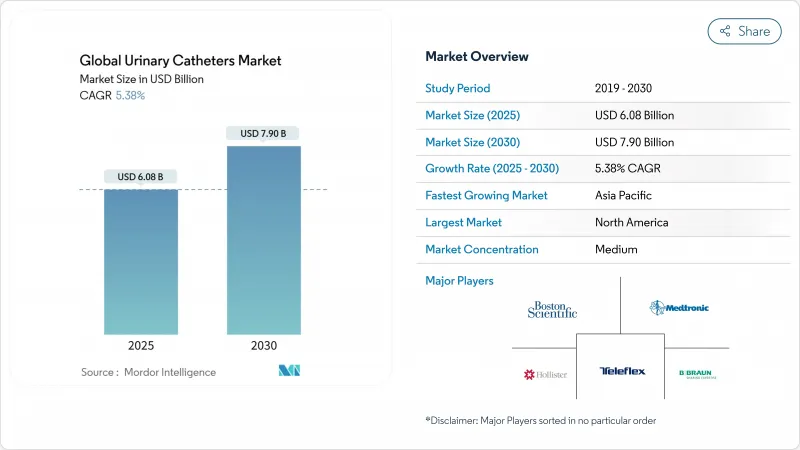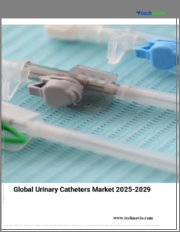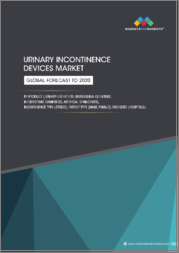
|
시장보고서
상품코드
1836689
세계의 요도 카테터 시장 : 시장 점유율 분석, 산업 동향, 통계, 성장 예측(2025-2030년)Global Urinary Catheters - Market Share Analysis, Industry Trends & Statistics, Growth Forecasts (2025 - 2030) |
||||||
요도 카테터 시장은 2025년에 60억 8,000만 달러로 추정되고, 2025-2030년 CAGR 5.38%로 성장할 전망이며, 2030년에는 79억 달러에 달할 것으로 예측됩니다.

성장을 지원하는 것은 인구 고령화, 요실금 유병률 증가, 항균 코팅 및 디지털 모니터링 기능을 융합시킨 지속적인 제품 혁신입니다. 가치 기반 의료 인센티브는 감염 위험을 줄이는 고급 카테터로 병원을 안내합니다. EU 의료기기 규제 및 DEHP의 단계적 폐지 계획 등 규제 요구에 따라 지속 가능한 바이오 머티리얼이 장려되고 개발 비용이 상승하는 한편, 환경 친화적인 설계의 틈새도 확산되고 있습니다. 경쟁 구도는 대기업 중시 시장 환경에서 점유율을 유지하기 위해 선도적인 기존 기업이 인수, 제휴 또는 새로운 코팅 화학제품을 출시함으로써 격화되고 있습니다.
세계의 요도 카테터 시장 동향 및 인사이트
요실금의 유병률 상승
간병 시설에서는 76.5%가 요실금이 있는 것으로 보고되어 있으며 요도 유치 카테터, 간헐 요도 카테터, 외뇨도 카테터에 대한 수요의 지속이 강조되고 있습니다. 기능성 요실금은 현재 증례의 45.5%를 차지하고 있으며, 노인 이외에도 대응 가능한 환자층이 넓어지고 있습니다. 피부염 및 전도와 같은 합병증은 간호 비용을 증가시키기 때문에 카테터는 일회용이 아니며 필수적인 치료 도구로 자리매김하고 있습니다. 요실금과 관련된 간호 시설에 대한 연간 지출은 50억 달러에 달하는 추세이며, 보험 회사는 2차 이환율을 감소시키는 제품을 지지하도록 촉구하고 있습니다. 숙련된 간병 시설과 재택 간병 시설에서는 진단률이 높기 때문에 견고한 내감염 설계의 중요성이 두드러집니다. 지역 거주 노인들 사이에서 보급률이 높아짐에 따라 제조업체들은 디지털 교육을 번들로 한 자기 카테터 유치 키트 공급에 명확한 기세를 느끼고 있습니다.
증가하는 노인 인구
전립선 비대증(BPH) 환자는 1990-2022년 2배 이상으로 증가했고, 1억 1,250만 명에 이르렀으며, 70세 이상 남성의 80%가 병을 앓고 있습니다. 척수 손상의 발생률은 100만 명당 23.77명으로, 수십년에 걸친 카테터 의존이 가해지는 한편, 인구 증가가 증례 수 증가의 95% 가까이를 차지하고 있습니다. 이러한 질병이 중복됨으로써, 신경인성 방광, 수술 후 저류, 만성 기능 장애에 대응한 디바이스 포트폴리오가 동일 환자에게 요구되는 복잡한 복수의 적응증에 대한 시나리오가 생깁니다. 의료 시스템이 고령화하는 코호트에서 다질환 합병증을 다루는 동안 조달 우선순위는 다양한 임상 요구를 충족하면서 재고를 간소화하는 다목적 플랫폼에 기울고 있습니다.
CAUTI의 높은 위험 및 비용 부담
집중치료실에서의 CAUTI 발생률은 평균 8.83%로, 재원일수가 길어지기 때문에 밸류베이스 구매 하에서는 금전적 페널티를 받습니다. 병원은 간호사 주도 제거 알고리즘을 전개하여 고관절 골절 환자의 유치율을 30%에서 6.7%로 줄였습니다. 고소득 국가 및 저소득 국가 사이에 큰 격차가 있기 때문에 항균 카테터 채용 곡선은 여전히 불균일합니다. 지불자는 확실한 감염 데이터가 있는 장치를 선호하지만, 지출 상한이 공급자에게 카테터 사용 기간의 단축을 촉구하고, 비싼 ASP가 유지되어도 판매 횟수는 감소하고 있습니다.
보고서에서 분석된 기타 촉진요인 및 억제요인
- 코팅 및 생체 재료의 기술적 진보
- 수술 건수 증가
- 실금에 대한 비카테터 요법의 가용성
부문 분석
유치형 폴리 디바이스는 2024년에 52.13%의 매출을 유지했고, 급성기 입원 의료의 요점으로 계속됩니다. 그러나 간헐적인 카테터는 감염 발생률 감소와 환자의 편의성 증거에 힘입어 연간 5.91%의 성장이 예상됩니다. 체외 카테터는 틈새 시장을 차지하지만 미국에서는 높은 사용자 만족도와 명확한 상환 코드로 이익을 얻고 있습니다.
현재 설계 경쟁은 친수성 코팅, 통합 윤활 팩, 항균 합금에 달려 있습니다. ConvaTec의 보고에 따르면, 친수성 모델은 이미 콘티넨스케어 매출의 60%를 차지하고 있으며, 2026년 발효된 새로운 HCPCS 상환 코드에 의해 프리미엄 채용이 촉진될 전망입니다. 마이크로홀 드레너지 채널 등의 기술적 진보로 잔액량은 6mL 이하가 되어 병원과 재택 환경 모두에서 환자의 안전성을 지원하는 기준이 되고 있습니다.
50세 이상 여성의 요실금 유병률이 61%이기 때문에 2024년 수요의 65.52%는 여성 사용자에 의한 것입니다. 남성 수요는 BPH나 전립선 절제술 후 케어에 간헐적 또는 일시적인 장치가 필요하기 때문에 2030년까지 연평균 복합 성장률(CAGR) 6.23%로 증가할 것으로 예측됩니다.
혁신의 경로는 해부학적 구조에 따라 다릅니다. ConvaTec은 여성 전용 간헐 라인을 출시하고 임상의의 강한 지원을 받아 유럽 전역에서 확대하고 있습니다. 남성 환자의 경우, 깨끗하고 간헐적인 자기 카테터 유치는 유치형에 비해 전립선 비대증 수술 후 합병증이 적습니다. 라텍스가 없는 외장을 중심으로 설계된 남성용 체외식 시스템은 삽입 시 외상을 완전히 없애는 것으로 예방적인 역할을 하며, 요도 카테터 시장은 성별 범위를 넘어 차별적인 성장을 기대할 수 있습니다.
지역 분석
북미는 2024년 매출의 40.61%를 차지했고, 메디케어에 의한 프리미엄 외부 시스템에 대한 상환과 비뇨기 질환에 대한 추정 110억 달러의 국가 지출에 지지되고 있습니다. 간소화된 510(k) 패스웨이는 기술 혁신을 촉진합니다. 최근의 승인에는 진단용 카테터가 필요 없는 무선 소변 유동태 플랫폼이 포함되지만 후속 치료 장비의 보급에 박차를 가하고 있습니다.
유럽은 엄격한 규정에 의해 형성됩니다. 현지 제조업체의 절반이 MDR 인증 취득 비용으로 제품 라인을 축소하고 자본력 있는 다국적 기업에 점유율이 집중되고 있습니다. 2030년 7월 발효된 DEHP 규제는 투입 비용이 20-40% 상승하는 데도 바이오플라스틱 기재로의 시프트를 가속시킵니다. 초기 단계의 녹색 포트폴리오를 가진 의료기기 제조업체는 구매 프레임 워크에 통합된 지속가능성 지표를 선호하는 병원 입찰을 획득할 가능성이 높습니다.
아시아태평양의 CAGR은 7.45%에 달할 전망이며, 이는 수술 건수 증가, 보험 적용 범위의 확대, 2030년까지 2,250억 달러 이상에 달할 것으로 예상되는 국내 의료기술 부문에 힘쓰고 있습니다. 중국의 척수 손상 환자 수는 1990년 이후 63% 증가하고 있으며 간헐적 카테터 수요의 지속적인 확대로 이어지고 있습니다. 대만과 같은 신흥 허브 국가는 카테터 수입에서 2자리 성장을 보여주며, 해외 제조와 현지화된 규제 노하우를 결합한 기업에 이익을 가져다줍니다. 그러나 다양한 상환 규칙이 있기 때문에 가격 편차를 피하기 위해 시장 진입을 위한 플레이 북을 사용자 정의해야 합니다.
기타 혜택 :
- 엑셀 형식 시장 예측(ME) 시트
- 3개월간의 애널리스트 서포트
목차
제1장 서론
- 조사의 전제조건 및 시장 정의
- 조사 범위
제2장 조사 방법
제3장 주요 요약
제4장 시장 상황
- 시장 개요
- 시장 성장 촉진요인
- 요실금의 유병률 상승
- 고령자 인구 증가
- 코팅 및 생체 재료의 기술 진보
- 수술 건수 증가
- 전자상거래에 의한 자기 카테터 유치 증가
- 여성용 외요도 기구의 도입
- 시장 성장 억제요인
- CAUTI의 높은 위험 및 비용 부담
- 실금에 대한 비 카테터 요법의 가용성
- 새로운 일회용 플라스틱 규제
- 고급 스마트 및 항균 카테터에 대한 상환 제한
- 밸류체인 및 공급망 분석
- 규제 상황
- 기술적 전망
- Porter's Five Forces 분석
- 구매자 및 소비자의 협상력
- 공급기업의 협상력
- 신규 참가업체의 위협
- 대체품의 위협
- 경쟁 기업간 경쟁 관계의 강도
제5장 시장 규모 및 성장 예측
- 제품 유형별
- 유치(폴리) 카테터
- 간헐 카테터
- 체외 및 콘돔 카테터
- 성별
- 남성
- 여성
- 용도별
- 요실금
- 전립선 비대증
- 척수 손상
- 수술 후 요폐
- 기타
- 최종 사용자별
- 병원
- 장기 간병 시설
- 재택 간병 시설
- 지역별
- 북미
- 미국
- 캐나다
- 멕시코
- 유럽
- 독일
- 영국
- 프랑스
- 이탈리아
- 스페인
- 기타 유럽
- 아시아태평양
- 중국
- 일본
- 인도
- 호주
- 한국
- 기타 아시아태평양
- 중동 및 아프리카
- GCC
- 남아프리카
- 기타 중동 및 아프리카
- 남미
- 브라질
- 아르헨티나
- 기타 남미
- 북미
제6장 경쟁 구도
- 시장 집중도
- 시장 점유율 분석
- 기업 프로파일
- Coloplast A/S
- Becton Dickinson & Company(incl. CR Bard)
- B. Braun Melsungen AG
- Teleflex Inc.
- Hollister Inc.
- Boston Scientific Corp.
- ConvaTec Group PLC
- Amsino International
- CompactCath Inc.
- Cure Medical LLC
- Cardinal Health
- Bactiguard AB
- Pennine Healthcare
- Go Medical Industries
- Medical Device Innovations Group
- Medtronic plc
- UroDev Medical
- WellSpect Healthcare
제7장 시장 기회 및 전망
AJY 25.10.27The urinary catheters market reached USD 6.08 billion in 2025 and is forecast to climb to USD 7.90 billion by 2030, reflecting a 5.38% CAGR across the period 2025-2030.

Growth is supported by population ageing, rising urinary incontinence prevalence, and continuous product innovation that blends antimicrobial coatings with digital monitoring features. Value-based care incentives are steering hospitals toward premium catheters that cut infection risk, while home-care adoption is accelerating as reimbursement expands. Regulatory demands such as the EU Medical Device Regulation and the planned DEHP phase-out are encouraging sustainable biomaterials, lifting development costs but also opening niches for eco-friendly designs. Competitive intensity is heightening as large incumbents acquire, partner or launch new coating chemistries to retain share in an increasingly outcomes-driven market landscape.
Global Urinary Catheters Market Trends and Insights
Rising Prevalence of Urinary Incontinence
Nursing homes report 76.5% incontinence prevalence, underscoring sustained demand for indwelling, intermittent and external devices . Functional incontinence now comprises 45.5% of cases, widening the addressable pool beyond older adults. Associated complications such as dermatitis and falls elevate care costs, positioning catheters as essential therapeutic tools rather than disposable commodities. Annual nursing-home expenditures tied to incontinence approach USD 5 billion, prompting insurers to back products that lower secondary morbidities. Higher diagnosis rates in skilled-nursing facilities versus home-care settings accentuate the importance of robust infection-resistant designs. As prevalence rises among community-dwelling seniors, manufacturers see clear momentum in supplying self-catheterization kits bundled with digital education.
Growing Geriatric Population
Benign prostatic hyperplasia (BPH) cases more than doubled from 1990 to 2022, reaching 112.5 million and affecting 80% of men older than 70. Spinal cord injury incidence of 23.77 per million adds decades-long catheter dependence, while population growth contributes nearly 95% of the uplift in case volumes. These overlapping morbidities create complex multi-indication scenarios that demand device portfolios tuned to neurogenic bladder, post-operative retention and chronic dysfunction in the same patient. As health systems grapple with multimorbidity in ageing cohorts, procurement priorities tilt toward versatile platforms that streamline inventory while satisfying diverging clinical needs.
High Risk & Cost Burden of CAUTI
Intensive-care CAUTI rates average 8.83% and extend hospital stays, attracting financial penalties under value-based purchasing. Hospitals are rolling out nurse-led removal algorithms that trimmed retention from 30% to 6.7% in hip-fracture patients, demonstrating that prevention can erode procedure volume. Wide disparity between high- and low-income countries means adoption curves for antimicrobial catheters remain uneven. Payors favor devices with robust infection data, yet spending caps push providers to shorten catheter duration, dampening unit sales even as premium ASPs hold.
Other drivers and restraints analyzed in the detailed report include:
- Technological Advances in Coatings & Biomaterials
- Increasing Surgical Procedure Volumes
- Availability of Non-Catheter Therapies for Incontinence
For complete list of drivers and restraints, kindly check the Table Of Contents.
Segment Analysis
Indwelling Foley devices retained 52.13% revenue in 2024 and remain the cornerstone of acute in-patient care. Intermittent catheters, however, are forecast to grow 5.91% annually, propelled by evidence of lower infection incidence and higher patient comfort. External catheters occupy a niche yet benefit from high user-satisfaction scores and clear reimbursement coding in the United States.
Design competition now hinges on hydrophilic coatings, integrated lubrication packets and antimicrobial alloys. ConvaTec reports that hydrophilic models already contribute 60% of Continence Care turnover, and new HCPCS reimbursement codes effective 2026 are expected to boost premium adoption. Engineering advances such as micro-hole drainage channels lower residual volumes to under 6 mL, a benchmark that supports patient safety in both hospital and home settings.
Female users generated 65.52% of 2024 demand due to a 61% prevalence of urinary incontinence in women older than 50. Male demand is projected to advance 6.23% CAGR through 2030 as BPH and post-prostatectomy care require intermittent or temporary devices.
Innovation pathways diverge by anatomy. ConvaTec launched a women-specific intermittent line that is scaling across Europe following strong clinician acceptance. For male patients, clean intermittent self-catheterization yields fewer complications after BPH surgery versus indwelling alternatives. External male systems designed around latex-free sheaths are carving a preventive role by eliminating insertion trauma altogether, positioning the urinary catheters market for differential growth across gender lines.
The Urinary Catheters Market Report Segments the Industry Into by Product Type (Indwelling (Foley) Catheters, Intermittent Catheters, and More), Application (Benign Prostate Hyperplasia (BPH), Urinary Incontinence, and More), End User (Hospitals, Home-Care Settings, and More), Gender (Male and Female) and Geography. The Report Offers the Value (in USD) for the Above Segments.
Geography Analysis
North America contributed 40.61% of 2024 sales, underpinned by Medicare reimbursement for premium external systems and an estimated USD 11 billion national spend on urologic disorders. Streamlined 510(k) pathways facilitate innovation: recent clearances include wireless urodynamic platforms that eliminate diagnostic catheters, yet still spur follow-on treatment device uptake.
Europe is shaped by stringent regulation. Half of local manufacturers trimmed product lines due to MDR certification costs, concentrating share with well-capitalized multinationals. The DEHP restriction effective July 2030 accelerates the shift to bioplastic substrates despite 20-40% higher input costs . Device makers with early-stage green portfolios are likely to capture hospital tenders that favor sustainability metrics embedded in purchasing frameworks.
Asia-Pacific is on track for a 7.45% CAGR, propelled by rising procedure volumes, expanding insurance coverage and a domestic medtech sector expected to top USD 225 billion by 2030. China's spinal cord injury caseload grew 63% since 1990, translating into sustained intermittent-catheter demand. Emerging hubs such as Taiwan show double-digit gains in catheter imports, benefiting firms that pair off-shore manufacturing with localized regulatory know-how. Diverse reimbursement rules, however, require tailored go-to-market playbooks to avoid pricing misalignment.
- Coloplast
- Becton Dickinson & Company (incl. C. R. Bard)
- B. Braun
- Teleflex
- Hollister
- Boston Scientific
- Convatec
- Amsino International
- CompactCath Inc.
- Cure Medical
- Cardinal Health
- Bactiguard AB
- Pennine Healthcare
- Go Medical Industries
- Medical Device Innovations Group
- Medtronic
- UroDev Medical
- WellSpect Healthcare
Additional Benefits:
- The market estimate (ME) sheet in Excel format
- 3 months of analyst support
TABLE OF CONTENTS
1 Introduction
- 1.1 Study Assumptions & Market Definition
- 1.2 Scope of the Study
2 Research Methodology
3 Executive Summary
4 Market Landscape
- 4.1 Market Overview
- 4.2 Market Drivers
- 4.2.1 Rising prevalence of urinary incontinence
- 4.2.2 Growing geriatric population
- 4.2.3 Technological advances in coatings & biomaterials
- 4.2.4 Increasing surgical procedure volumes
- 4.2.5 E-commerce-enabled rise in self-catheterisation
- 4.2.6 Introduction of female external urine-management devices
- 4.3 Market Restraints
- 4.3.1 High risk & cost burden of CAUTI
- 4.3.2 Availability of non-catheter therapies for incontinence
- 4.3.3 Emerging single-use plastics regulation
- 4.3.4 Limited reimbursement for premium smart/antimicrobial catheters
- 4.4 Value / Supply-Chain Analysis
- 4.5 Regulatory Landscape
- 4.6 Technological Outlook
- 4.7 Porter's Five Forces Analysis
- 4.7.1 Bargaining Power of Buyers/Consumers
- 4.7.2 Bargaining Power of Suppliers
- 4.7.3 Threat of New Entrants
- 4.7.4 Threat of Substitute Products
- 4.7.5 Intensity of Competitive Rivalry
5 Market Size & Growth Forecasts
- 5.1 By Product Type
- 5.1.1 Indwelling (Foley) Catheters
- 5.1.2 Intermittent Catheters
- 5.1.3 External/Condom Catheters
- 5.2 By Gender
- 5.2.1 Male
- 5.2.2 Female
- 5.3 By Application
- 5.3.1 Urinary Incontinence
- 5.3.2 Benign Prostate Hyperplasia
- 5.3.3 Spinal Cord Injury
- 5.3.4 Post-operative Urinary Retention
- 5.3.5 Others
- 5.4 By End User
- 5.4.1 Hospitals
- 5.4.2 Long-term Care Facilities
- 5.4.3 Home-care Settings
- 5.5 By Geography
- 5.5.1 North America
- 5.5.1.1 United States
- 5.5.1.2 Canada
- 5.5.1.3 Mexico
- 5.5.2 Europe
- 5.5.2.1 Germany
- 5.5.2.2 United Kingdom
- 5.5.2.3 France
- 5.5.2.4 Italy
- 5.5.2.5 Spain
- 5.5.2.6 Rest of Europe
- 5.5.3 Asia-Pacific
- 5.5.3.1 China
- 5.5.3.2 Japan
- 5.5.3.3 India
- 5.5.3.4 Australia
- 5.5.3.5 South Korea
- 5.5.3.6 Rest of Asia-Pacific
- 5.5.4 Middle East & Africa
- 5.5.4.1 GCC
- 5.5.4.2 South Africa
- 5.5.4.3 Rest of Middle East & Africa
- 5.5.5 South America
- 5.5.5.1 Brazil
- 5.5.5.2 Argentina
- 5.5.5.3 Rest of South America
- 5.5.1 North America
6 Competitive Landscape
- 6.1 Market Concentration
- 6.2 Market Share Analysis
- 6.3 Company Profiles (includes Global level Overview, Market level overview, Core Segments, Financials as available, Strategic Information, Market Rank/Share for key companies, Products & Services, and Recent Developments)
- 6.3.1 Coloplast A/S
- 6.3.2 Becton Dickinson & Company (incl. C. R. Bard)
- 6.3.3 B. Braun Melsungen AG
- 6.3.4 Teleflex Inc.
- 6.3.5 Hollister Inc.
- 6.3.6 Boston Scientific Corp.
- 6.3.7 ConvaTec Group PLC
- 6.3.8 Amsino International
- 6.3.9 CompactCath Inc.
- 6.3.10 Cure Medical LLC
- 6.3.11 Cardinal Health
- 6.3.12 Bactiguard AB
- 6.3.13 Pennine Healthcare
- 6.3.14 Go Medical Industries
- 6.3.15 Medical Device Innovations Group
- 6.3.16 Medtronic plc
- 6.3.17 UroDev Medical
- 6.3.18 WellSpect Healthcare
7 Market Opportunities & Future Outlook
- 7.1 White-space & Unmet-need Assessment

















